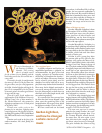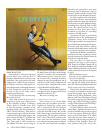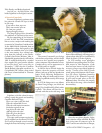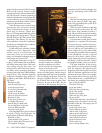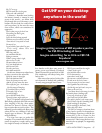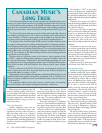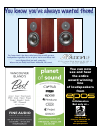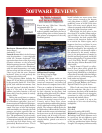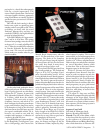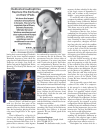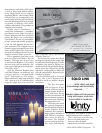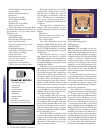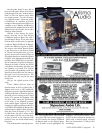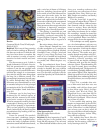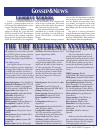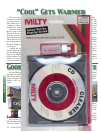
Feedback
Software
paying for it, a detail that subsequently
took on a certain importance). The
reason I hadn’t heard them: Dorian had
reinvented public relations, apparently
using North Korea as a model, and when
was the last time you received a CD from
Pyongyang?
But with the back catalog in distri-
bution once again we opened up some
samples, and we were glad we did. These
recordings are done with the usual
Professor Johnson flair, and they are
encoded in HDCD, the high definition
process he helped develop.
Felix Hell is billed as an “organ sensa-
tion,” and he is all of that. This young
German-born prodigy moved to the US
at the age of 14…to study at Juilliard! He
was 17 when he recorded this collection
in Lincoln, Nebraska. By then he had
given some 250 concerts worldwide,
which makes one wonder when he gets
time for studies.
On the other hand, perhaps he knows
all he needs to know for the moment, at
least if I go by the music on this album,
all from the 19
th
Century. It opens with
Felix Alexandre Guilmant’s Sonata No. 1
in D Minor, which bears the subtitle
Symphonie. This is not truly an organ
symphony, however, and much of it is
more introspective than the powerhouse
organ works that have long been used as
hi-fi showpieces. Only in the third and
final movement does Hell open up with
the organ’s considerable muscle. He is,
however, very much at ease with the
complex softer passages, a reflection of
a maturity beyond his years.
Joseph Rheinberger, represented here
by his Abendfriede (“evening peace”) was
also a child prodigy, who entered the
Munich Royal Conservatory when he
was 11. No fireworks here, as the name
suggests. The finale of the Symphony
No. 1 of Louis Vierne, long the organist
of Notre-Dame de Paris, has lots more
fire, and I have heard it many times,
though it has always left me cool.
It was when Felix Hell gets into Liszt
that I really perked up. The Prelude and
Fugue on B-A-C-H is perhaps Liszt’s
most forward-looking music, all but
leaving behind the tone-based composi-
tions that had always dominated Western
music. The title is a pun on the name of
Johann Sebastian Bach (note that this is a
prelude and fugue), but is also a reference
to the German names of the notes B-flat,
A, C and B. There is no key signature
stated, because Liszt used as much as he
could of the black and white notes of the
keyboard. The overall tone and structure
are closer to the 20
th
Century than to the
18
th
. A number of organists play it with
great flamboyance because…well, this
is Liszt, after all. It benefits from more
respect for its structure, which is why I
prefer it played by Fernando Germani
than by E. Power Biggs, say (I’ve been
lucky enough to hear both live). Hell is
closer to Germani, and he never either
reaches for an easy effect or gets lost in
the complexity of the music.
The CD ends with a longer Liszt
piece, the Fantasy and Fugue on “Ad Nos
ad Salutarem Undam, inspired by Mey-
erbeer’s opera Le prophète. This is rather
austere music, as you might suppose from
the fact that the opera was about John of
Leyden, a 16
th
Century religious fanatic.
However there are some dense variations
on one of Meyerbeer’s themes, which
is what drew Liszt to this (now) almost
forgotten opera in the first place.
Keith O. Johnson has placed his
microphones some distance from the
organ in order to capture not only the
sound of the pipes but also of the rever-
berant interior or the First-Plymouth
Congregational Church. Despite the
distance the focus is excellent, and as the
music progresses you get a good mental
picture of the place. Recording levels are
fairly low, with plenty of room for the
pleins jeux passages.
The organ is a large one, and Felix
Hell and the composers he plays take full
advantage of the larger pipes. I found
myself wondering what would be left of
this music on a system without extreme
bass response. On the Omega system it
is awesome to listen to.
Argento: Casa Guidi
Von Stade & Minnesota Orch.
Reference Recordings RR-100CD
Lessard: The title of the album, which
is also that of the first work on it, refers
to the residence of celebrated poets
Elizabeth Barrett and Robert Browning,
who exiled themselves to Florence fol-
ULTRA HIGH FIDELITY Magazine 71



